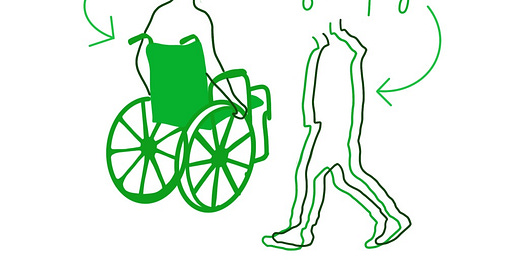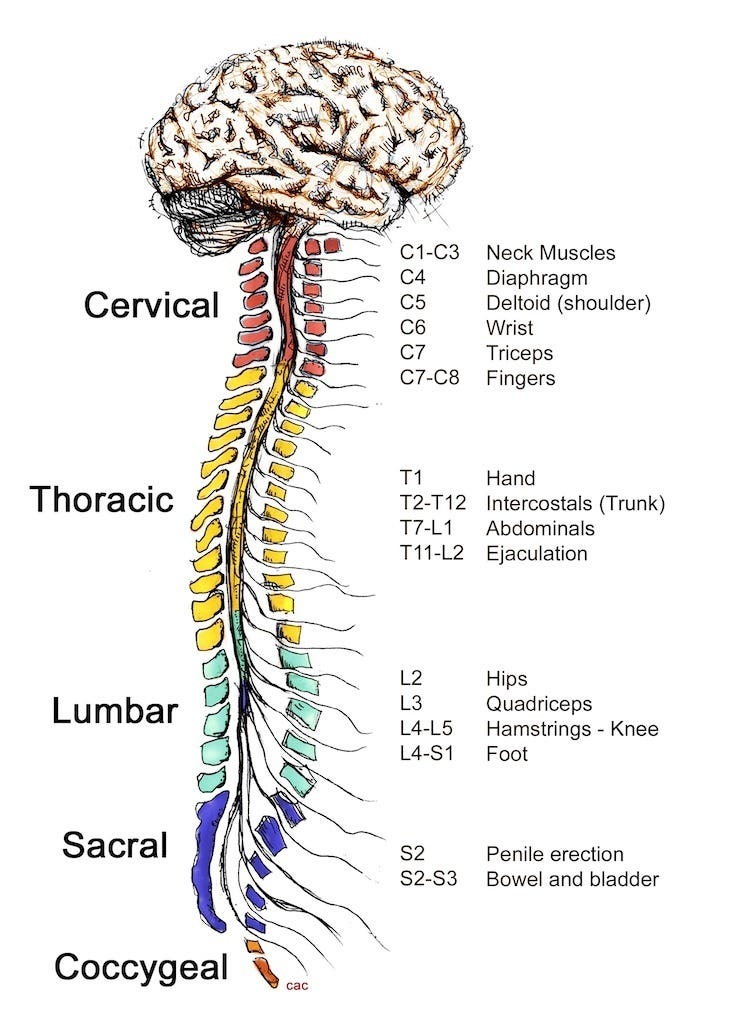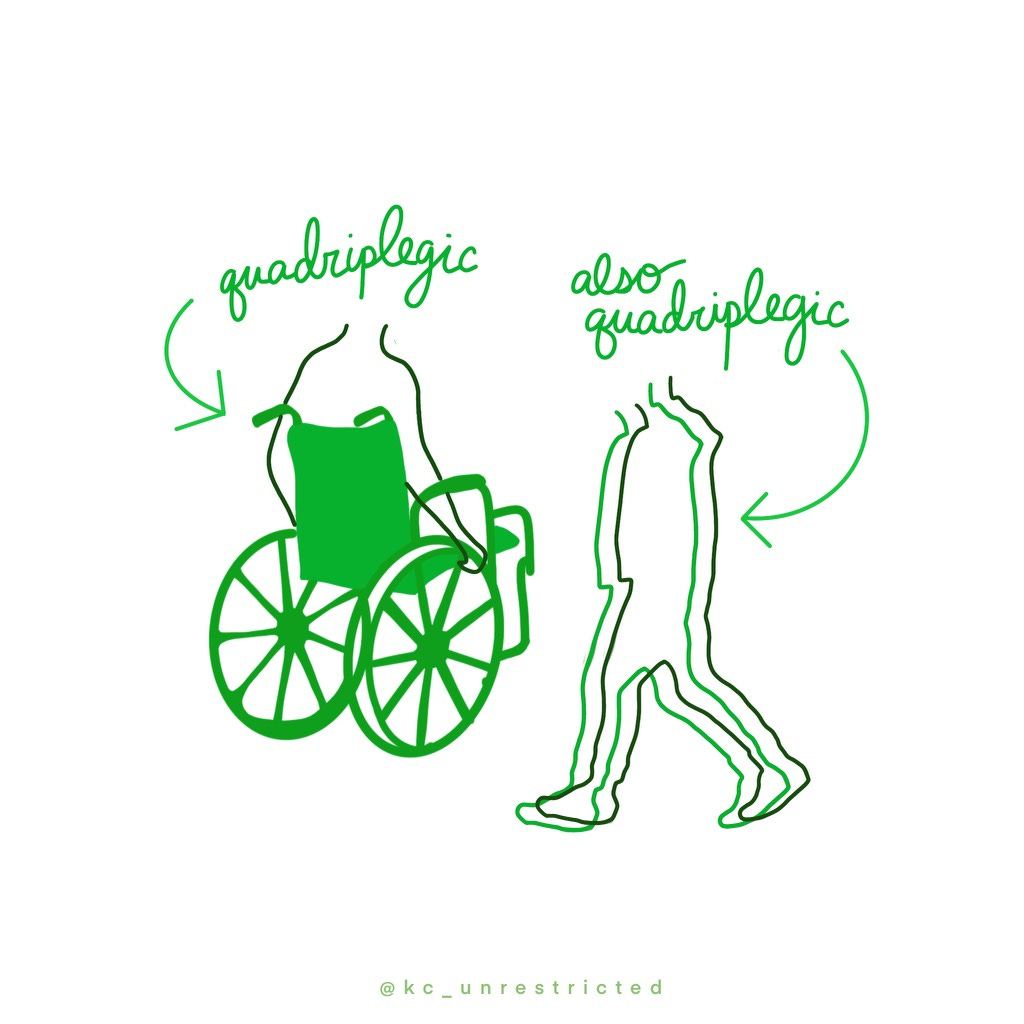Before my spinal cord injury, I was quite ignorant of the world of neurological conditions. I understood these conditions were serious, as people with them often lost the ability to walk, talk, or remember. Besides this, though, I was unaware of what these people experienced.
In this post, I want to dig into quadriplegia—a phenomenon I have lived and breathed. I will provide a thorough definition, describe common symptoms, and answer the title of this post.
Let’s dive in.
Quadriplegia Defined
Quadriplegia is a form of paralysis (the inability to voluntary move a body part) that affects all four limbs. Quadriplegia is often the symptom of an injury to the neck region of the spinal cord. These injuries range from blunt trauma to a vascular or autoimmune event. While all of these injuries have different causes, their outcomes are generally similar—a pattern of paralysis in all four limbs.
The spinal cord is composed of several bundles of nerves that transmit sensory information from your limbs and core to your brain. It also transmits motor commands from your brain to your muscles. Here’s an example of the spinal cord in action. If you are sitting in a chair, the sensory nerves in your glutes are constantly sending a pressure signal up your spinal cord to your brain. Subconsciously, you will shift your weight to reposition yourself by sending motor commands down your spinal cord to your glutes and other relevant muscles. If the spinal cord was not present in this process, your brain would never know your glutes were receiving pressure, and you would end up with pressure sores. Further, without your spinal cord, you wouldn’t have been able to reposition in your seat even if you wanted.
The spinal cord is split into four primary regions (cervical, thoracic, lumbar, and sacral) based on location and function. It extends from the base of your neck to your tailbone. Below is a diagram of the regions with their main functions.
As you may have noticed, the nerves leaving the spinal cord innervate muscles in nearby areas (e.g., nerves leaving the spinal cord in your neck innervate your shoulders, not your hips). Further, you might have observed that nerves innervate more than just your skeletal muscles—the bladder, bowel, and sexual function can also be impacted by injury (more on this later).
One last important point before we move on to common symptoms. Remember when I said the spinal cord is composed of several nerve bundles? As we move from the top of the spinal cord to its base, the thickness of each of those bundles decreases because nerves are branching off at each vertebral opening. If we isolated one bundle and severed it, all signal from that point and downward would be lost because it would no longer be connected to the brain. Thus, injuries in the cervical or neck region do not just affect shoulder and arm functions—they also affect leg, bladder, bowel, and sexual function capabilities.
Common Symptoms
When most people think of quadriplegia and paralysis, they think of a lack of motion. While this is certainly true, it is just the tip of the iceberg.
Here is a non-exhaustive list of symptoms:
Complete or partial inability to move your arms and legs.
Difficulty breathing. Your diaphragm is innervated by nerves that branch from your cervical spinal cord. If these nerves are injured, you likely will not have the ability to breathe and will need to be intubated.
Pain and/or numbness. If the sensory bundles of your spinal cord are injured, you can experience a range of sensations below your injury line. You may not be able to feel anything—as if you were floating in space. You may feel numbness and tingling. You may feel intense pain.
Bowel and bladder incontinence. Your brain sends signals via your spinal cord to help you use the restroom, typically by relaxing relevant pelvic floor muscles. If this connection is interrupted, you may have bladder and bowel accidents.
Sexual dysfunction. You may have trouble obtaining and sustaining erections—even if you are aroused. Further, ejaculation may not be possible or at least more difficult to achieve.
Can a Quadriplegic Walk?
The medical definition of quadriplegia is not determined by whether someone can walk or not. The definition is met if a person has paralysis in all four limbs.
Quadriplegics are thus not monoliths. No two quadriplegics will have the same pattern and degree of paralysis as no two injuries are identical. Two quadriplegics could have injuries in the same location. However, if one quadriplegic had his spinal cord severed completely while the other had slight bruising of his cord, their impaired functions would be much different.
A quadriplegic can walk if function is recovered in his legs and core. This is not always possible, and doctors cannot predict what or how much function will be recovered after an injury.
I was in a position where I could recover function in my legs, arms, and core, which allowed me to slowly start walking again. I went through a series of less-assistive leg braces and walkers as I became stronger. After almost eight years, I can walk a few blocks on my best days before I need a sitting break. On my worst days, moving around my apartment is difficult. My walking technique or gait is highly inefficient due to the paralysis throughout my core and legs, so I exert a lot of energy when walking. I walk with a limp as my right leg is more affected than my left.
Conclusion
Quadriplegia is a rabbit hole, and many neurologists spend their entire careers studying it. I have only the skimmed the surface of this topic, but I hope you feel more educated after reading.
Feel free to share this post if you desire.
—KH




